Admiral Sampson
The Admiral Sampson was built in December 1898 by William Cramp & Sons Shipbuilding Co. in Philadelphia Pennsylvania. She was a twin screw and approximately 296 feet in length and 2,104 tons.
The Admiral Sampson was built for the American Mail Steamship Company along with her sister ships, Admiral Dewey, Admiral Schley, and Admiral Farragut. When she was ready to launch, people came from all over to watch the spectacular event as well as the christening by Nannie Sampson, the daughter of Admiral Sampson.
The Sampson had an interesting career as a carrier ship of fruit, mail, and passengers for the United Fruit Company, Through the years there were several mergers and sales of companies that would toss around ownership of the Admiral but eventually she would be a part of the Alaska Pacific Steamship Co., founded in 1906, which was merged with Alaska Coast Co, in 1912 to form the Pacific Alaska Navigation Co. The final owner that would see her demise.
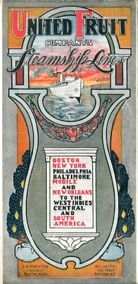
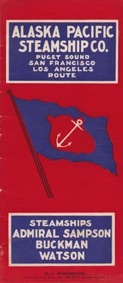
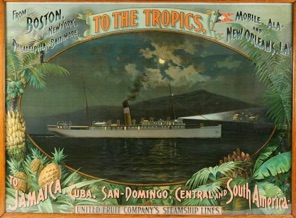
(Courtesy Maritime Timetable Images) (Thomaston Place Auction Galleries)
On August 26th, 1914 The Admiral Sampson left Seattle for Alaska with about 160 passengers on board. It was foggy that day, and the captain, Zimro Moore ordered the engines slowed and she crawled at 3 knots. Extra lookouts were ordered, and the ships whistle would sound at frequent intervals.
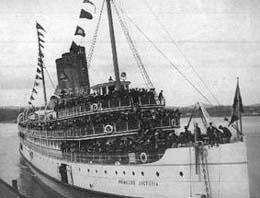
While passing Point No Point, the S.S. Admiral Sampson was struck broadside by the Princess Victoria. Piercing the Sampsons Steel hull with her bow, the Victoria stayed locked to the Admiral so that the passengers of the Sampson could unload to the Princesses deck. Unfortunately, the Victoria struck directly inline with the Sampsons after hatch opening, creating a 12 foot gash in the hull. This also crushed several large containers of fuel oil, which in turn caught fire. The Victoria was forced to back away leaving the Admiral open for the sea to rush into her.
In the mean time the radio men were communicating with outside authorities for help. According to Karl Baarslag's book "SOS to the Rescue", there is a monument dedicated to the brave radio men who lost their lives at sea, and upon that monument there are 25 names. One of the names is Walter E. Reker, radio man of the Admiral Sampson. His brief story is as follows:
Walter Reker sent out for help via wireless communication and stood by his post until the radio men of the Victoria had advised him that they had sent for assistance and there was no need to stand his post any longer. Time was short. The Sampson was engulfed in flames and the Victoria had separated herself from the wounded Admiral, but Reker refused to abandon ship. Instead he took his place among the crew assisting passengers into the lifeboats. Refusing repeated orders to save himself, he waited until the last boat had left and almost all the passengers had gone to safety. He then reported to the bridge and sank with the ship to his death. Standing with him was Captain Zimro Moore.

1. Captain Zimro Moore
2. A.J. Noon
3. W.E. Reker
4. Miss M. Campbell
5. A. Sater
6. L. Cabaranas
7. C.M. Marquist
8. J.C. Williams
9. Mrs. George Banberry
10. Ezra Byrne
11. C.W. Bryant
12. W. Hoffem
13. J.H. Cline
14. William Klovitch
15. John McLaughlin
16. (unknown 2nd class passenger)
The Admiral Sampson now lays in 320 feet of water off Point No Point Washington.
GOING AFTER THE ADMIRALS DIAMONDS.
In September 1991, Kent Bernard and Gary Severson began looking for the Sampson with side scan sonar. After only 4 hours he noticed a hull sitting upright in 320 feet of water, in two pieces.
In December of the same year, Bernard returned with the St.Jude, a 110 ft dive platform and one Newtsuit. The Newtsuit is a one atmosphere armored diving suit that looks like a suit of armor on steroids. Along with rescuing a lost ROV, Fuoco, the man in the suit, was supposed to survey the wreck site. Getting tangled himself, he had to be rescued by another open circuit diver by the name of Curt Newman. Once that task was accomplished Newman got to do a bit of survey himself. The site overwhelmed him.
In June of 1992, Bernard hired Delta Oceanographic of LA. The owned a 17 ft, two man submersible which could easily handle the 3 knot currents which swept the wreck. They noticed the stern section was about 30 ft aft of the collision point, broke completely apart when she sank and hit stern first. The stern was laying on its starboard side. The submersible’s arm was able to collect various artifacts including an 80-pound bronze steam whistle and pulley.
With the Sampson mapped out, Bernard, Severson and Argonaut Resources decided it was time to go after the diamonds in the purser’s safe. Hiring Sonsub of Houston, they used the Viper ROV to do the salvage work. In September 1994 Sonsub came to Seattle with 4 operators and one Viper. They set up the motor barge Sea Horse over the wreck, and the work commenced around the clock. The Sea Horse crew would lower a grappling hook, attached to a crane, and the Viper would attach it to large debris covering the safe. In the process several more artifacts were uncovered including the telegraph, the bronze wheel pedestal with the markings, “Wm. Cramp & Sons, Williamsons & Co., Philidelphia, 1889,” a toilet bowl, more teacups, soup bowls, and china, as well as 2 huge sterling silver coffee urns. Also the bronze “D” and “S” from the stern “Admiral Sampson” were recovered.
Although the safe hadn’t been found, Bernard had to quit because they were already over budget on the salvage. The team received national publicity for their work and planned to hold an auction to recoup some of their costs. Every item was sold except 3 major pieces, which eventually went to Whatcom County Maritime Museum in Bellingham.
From Article, The Admiral’s Diamonds By Eric Morris


Courtesy UW Libraries Special Collections
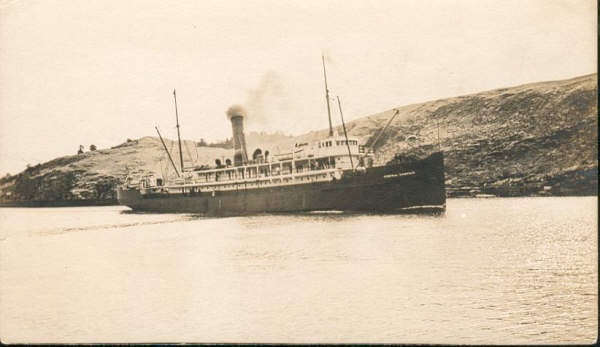
Courtesy Rob Wilson
Photo #2; Courtesy Maritime Museum of British Columbia
Photo #3; Courtesy University of Alaska Fairbanks

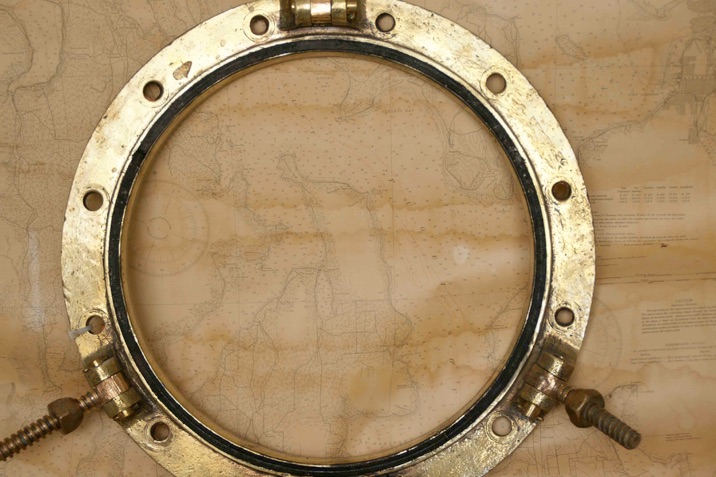
Bell and porthole photos courtesy of Gary Severson



-
-Home
